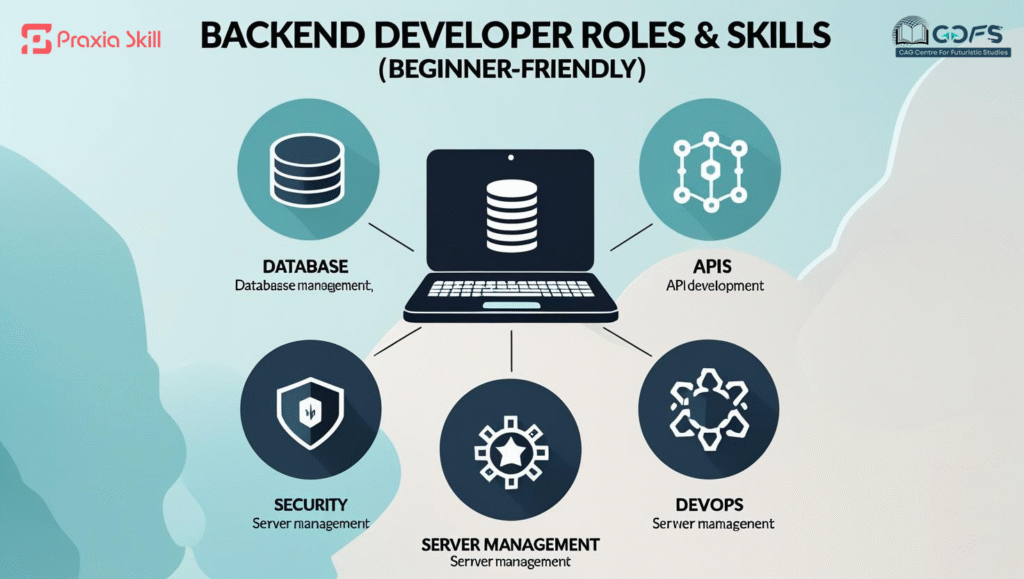When you scroll through Instagram, order something from Amazon, or watch a video on YouTube, everything feels smooth and effortless. You tap a button, and instantly something happens—your order gets placed, your video plays, or your message is sent. But have you ever wondered how all this magic happens behind the scenes?
That’s where backend developers come in. If frontend developers are responsible for the “look and feel” of an app (what you see and interact with), backend developers are the hidden architects who make sure everything works. They design and maintain the “brain” of applications—handling data, logic, security, and connections.
In this blog, we’ll explore the key responsibilities of a backend developer in a beginner-friendly way. If you’re curious about backend developer skills or want a beginner’s guide to backend development, this post will break it down for you.
-
Building and Maintaining Server-Side Logic
Imagine you log in to your Amazon account. You type your email and password, and within seconds, Amazon recognizes you, shows your shopping history, and recommends products.
That “thinking” part—checking if your password is correct, pulling up your saved cart, and showing personalized recommendations—happens on the server side.
Backend developers write the server-side logic that powers these operations. It’s like the control room of an application, hidden from the user but making sure every feature works correctly.
For example:
- When you hit “Pay Now” while shopping online, the backend ensures your payment is processed safely and the order is created.
- When you search for a video on YouTube, the backend finds the right matches and delivers them to your screen.
In short, backend developers make sure apps don’t just look good—they actually think, respond, and work properly behind the scenes.
-
Working with Databases
Think of a database as a giant digital library. Instead of books, it stores data—like usernames, passwords, order details, messages, and videos.
Every time you interact with an app, the backend communicates with the database to store, retrieve, or update information. For example:
- When you save a new contact in WhatsApp, the backend stores it in the database.
- When you log into Instagram, the backend checks the database to verify your username and password.
- When you buy something on Amazon, the backend updates the database to reduce the stock count.
Backend developers are responsible for designing, maintaining, and optimizing these databases. They make sure data is stored securely and can be accessed quickly whenever you need it.
Without this responsibility, apps would forget your information every time you closed them. Imagine logging into Instagram every single time from scratch or losing your order details—chaos, right? That’s why database management is one of the most important backend developer skills.
-
Ensuring Application Security and Performance
Security and performance are two things users don’t always notice—until something goes wrong.
Security means protecting sensitive data like your login details, credit card numbers, and personal information. For instance:
- When you log in to your bank’s mobile app, the backend ensures your data is encrypted and safe from hackers.
- Passwords are not stored as plain text; they’re hashed (a process that makes them unreadable).
Performance, on the other hand, is about speed and efficiency. Imagine waiting 10 seconds every time you clicked on a YouTube video—it would drive you crazy! Backend developers work hard to make sure applications run fast, even when millions of people are using them at the same time.
In short:
- Security = Keep data safe.
- Performance = Keep apps fast and smooth.
Together, these ensure that users trust and continue using applications.
-
Integrating APIs and Third-Party Services
Have you ever ordered food from Zomato or Swiggy and tracked your delivery on a map? That’s not something Zomato built from scratch—it’s powered by Google Maps API.

APIs (Application Programming Interfaces) allow different applications to talk to each other. Backend developers are responsible for integrating these APIs so apps can access outside services.
Some common examples include:
- Payment gateways like PayPal, Razorpay, or Stripe (to handle payments securely).
- Social logins like “Login with Google” or “Login with Facebook.”
- Third-party services like weather updates, shipping tracking, or chatbots.
By connecting these services, backend developers save time and make apps smarter. Instead of reinventing the wheel, they use existing tools to provide powerful features.
Why Backend Developers Are the Unsung Heroes
When you think of apps like Instagram, Amazon, or YouTube, it’s easy to appreciate the design and visuals. But the truth is, without backend developers, none of these apps would function.
They are the ones who:
- Make sure your login works.
- Ensure your data is safe.
- Keep apps running fast, even under heavy load.
- Connect apps with services that make them more useful.
Conclusion
Backend development often works in the shadows, but it’s truly the backbone of every app you use. Whether it’s making sure your login works, keeping your data safe, or connecting your favourite apps with services like maps and payments, backend developers quietly handle it all to keep the digital world running without a glitch.
If you’re just starting out in tech, learning backend development is like stepping into the role of a problem solver. You become the person who ensures that apps don’t just look good, but work—smoothly, reliably, and at scale, even when millions of people are using them at the same time.
So, the next time you scroll through Instagram, binge on YouTube, or order your favorite meal online, remember the invisible heroes making it all happen—the backend developers who keep everything running seamlessly in the background.



